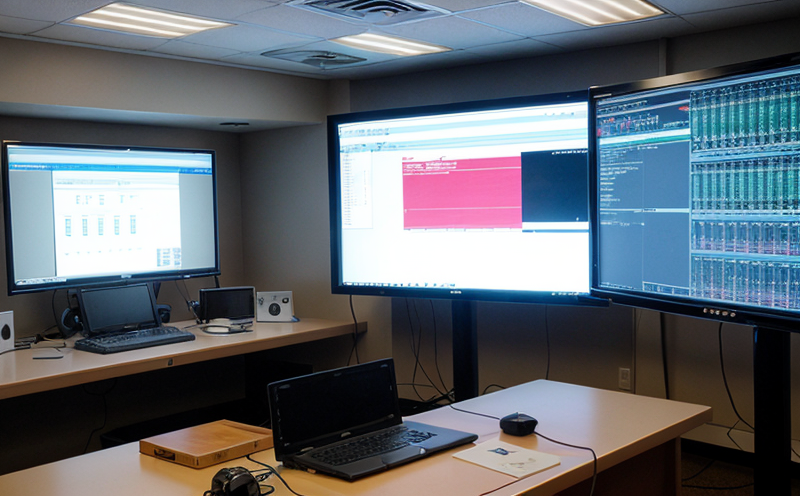EN 50129 Validation of SIL 4 Interlocking Systems
The European standard EN 50129 provides guidelines for the safety integrity level (SIL) assessment of signaling and interlocking systems in railway applications. This standard is crucial for ensuring that critical railway infrastructure operates safely and reliably, minimizing the risk of accidents or failures.
The EN 50129 validation specifically targets systems that are classified as SIL 4. This is the highest SIL level, indicating that the system must have a very high degree of safety integrity. These systems are typically found in critical railway infrastructure where any failure could lead to severe consequences.
The testing involves rigorous procedures designed to evaluate the probability of failure on demand (PFD) and other relevant parameters that determine whether the system meets the stringent requirements for SIL 4 compliance. The process includes simulation, analysis, and demonstration of the system’s ability to function correctly under various fault conditions.
Our service ensures that railway companies can confidently demonstrate compliance with EN 50129 and achieve the necessary certification for their signaling and interlocking systems. This is essential not only for regulatory compliance but also to enhance public trust and safety.
The testing process involves multiple stages, including:
- Initial hazard analysis,
- Detailed fault tree analysis,
- Component-based tests,
- Siliconization of the system design,
- Simulation and demonstration under various fault scenarios,
- Evaluation of the PFD against the required SIL 4 criteria.
The rigorous nature of this process ensures that any potential risks are thoroughly identified and mitigated, thus providing a robust framework for railway safety. Our team uses state-of-the-art tools and methodologies to ensure accurate and reliable results.
Scope and Methodology
The scope of the EN 50129 validation service encompasses a comprehensive assessment of SIL 4 interlocking systems used in railway signaling. The methodology follows the standard’s guidelines meticulously, ensuring that all requirements are met.
The testing process is divided into several key phases:
| Phase | Description |
|---|---|
| Hazard Identification and Analysis | This phase involves identifying potential hazards within the system. This includes a thorough examination of the system’s components, processes, and interfaces to determine where failures could occur. |
| Component-Based Testing | Each component is tested individually to ensure it meets the required safety integrity level criteria. This phase also includes testing under simulated fault conditions to assess resilience. |
| Siliconization of Design | The design process is meticulously documented and reviewed to ensure that all elements are aligned with the highest standards for SIL 4 systems. |
| Simulation and Demonstration | The interlocking system is subjected to various fault scenarios, simulating real-world conditions. This phase aims to demonstrate the system’s ability to function correctly under adverse circumstances. |
| Evaluation of PFD | The probability of failure on demand (PFD) is calculated and compared against the required SIL 4 criteria. This ensures that the system meets or exceeds the necessary safety integrity level. |
Additionally, we ensure compliance with the latest revisions of EN 50129 and any relevant amendments that may impact the testing process.
The methodology is designed to provide a robust, transparent, and verifiable approach to ensuring the safety integrity of railway signaling systems. Our team works closely with clients to ensure that all aspects of the test are carried out in accordance with best practices and international standards.
Why Choose This Test
Ensure compliance with EN 50129 and achieve SIL 4 certification.
Minimize risks associated with railway signaling failures by validating system safety integrity levels (SIL).
Enhance public trust in railway operations through rigorous safety assessments.
Comply with regulatory requirements, ensuring ongoing compliance and reducing the risk of penalties or sanctions.
Avoid costly rework and delays by identifying potential issues early in the testing process.
Gain a competitive edge by demonstrating your commitment to safety and quality standards.
Our service provides a comprehensive approach that ensures railway signaling systems meet the highest international standards for safety integrity. By choosing this test, you are investing in the long-term reliability and safety of your infrastructure.
International Acceptance and Recognition
The EN 50129 standard is widely recognized across the European Union and beyond. It has been adopted by numerous railway operators, manufacturers, and regulatory bodies as a benchmark for ensuring the safety integrity of signaling systems.
The standard’s focus on SIL 4 interlocking systems ensures that critical railway infrastructure meets stringent safety requirements. This recognition enhances your reputation as a leader in railway safety and innovation.
Our service aligns with this global acceptance, providing you with the necessary certification to operate your systems within regulatory frameworks and international standards. This not only simplifies compliance but also positions your company at the forefront of railway safety technology.





